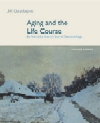1. How do environmental hazards, developmental processes, and genetic
tendencies contribute to the aging process?
Most scientists agree that aging is probably caused by a combination of environmental,
developmental, and genetic factors, but they disagree on which factors may be
most important. Two theories, the wear and tear theory and the somatic mutation
theory, emphasize the role of the environment. The wear and tear theory, which
is based on the idea that the body is like a machine that simply wears out,
is now largely discounted. The somatic mutation theory holds that environmental
insults cause genetic damage, which hastens aging. Several other theories highlight the role of developmental processes and genetic
programming. The immune function theory of aging emphasizes the gradual breakdown
of the immune system as the central cause of aging. Another theory, the cross-linkage
theory of aging, is based on the idea that the gradual accumulation of cross-linked
collagen causes a number of bodily changes associated with aging, such as hardening
of the arteries and stiffness of joints. A third theory emphasizes the role
of free radicals, unstable molecules that are implicated in a number of diseases.
Finally, according to genetic control theory, our life span is programmed into
our genes. 2. What is the difference between normal aging and pathological aging?
Biological aging refers to the structural and functional changes that occur
in an organism over time, beginning at maturity and lasting until death. This
normal process of aging is rarely lethal on its own. Instead, aging-dependent
diseases, including cancer, diabetes, heart disease, osteoporosis, and Alzheimer's
disease, increase a person's vulnerability to stress and the probability of
death. This increased vulnerability is called senescence. While disability rates
increase as people age, most people spend most of their lives free of disability. 3. How does aging change a person's physical appearance and mental
functioning?
As we age, a number of changes occur in the skin. Some, such as wrinkles, sagging
chins, and age spots, have no health consequences. The risk of skin cancer also
increases with age, because of the cumulative effects of a lifetime of exposure
to the sun. Age-related changes in the nervous system, which coordinates all
other body systems, can affect walking, sleep patterns, learning, and memory.
As people age, they spend more time in the lighter stages of sleep and awaken
more often during the night. Because of changing sleep patterns, older people
are more prone to chronic insomnia. They are also more likely to fall. 4. How does aging affect a person's sensory organs?
As people age, they lose sensitivity to perceptual experiences associated with
vision, hearing, taste and smell, and touch. Older people need more light to
see clearly and may have trouble seeing in the dark. They also may have presbyopia,
which refers to an inability to focus on near objects. Two visual disorders
that become increasingly common with advancing years are cataracts and glaucoma.
Both can be prevented or cured with proper medical treatment. As people age,
their ability to receive and interpret sound declines. The loss of hearing can
lead an otherwise healthy individual to become socially isolated from family
and friends. Taste and smell being closely related, as people lose their ability
to smell distinct odors, their sense of taste also suffers. A loss of taste
in turn affects eating habits. People who can't taste their food may eat less
and become malnourished. Finally, the sense of touch, especially in the fingertips,
diminishes with age as does the ability of the body to regulate heating and
cooling. As a result, older people are more affected by heat waves or cold spells.
Since most of these changes occur gradually, most older people adjust to them
by making incremental changes in their lifestyles. 5. -What effects does aging have on the bones, joints, and muscles?
Bone depletion is a natural part of aging that begins as young as age 30. One
of the more serious consequences of bone loss is osteroporosis. Those at greatest
risk of osteoporosis are small-boned postmenopausal women. New treatments for
osteoporosis promise to increase bone density and improve the quality of life
for older women. In both women and men, the most common cause of disability in later life is
arthritis, a disease of the joints. Mild arthritis causes pain and discomfort;
severe forms, like rheumatoid arthritis, can be crippling. The development of
artificial joints has restored freedom of movement to severely arthritic persons. Finally, as people age, their muscles atrophy and their strength declines.
Studies show that strength training and other forms of exercise can dramatically
reduce the loss of muscle strength in the aged. 6. -How does aging change a person's sexual capacity?
Menopause signals the end of a woman's fertility. The physical changes associated
with menopause include hot flashes and the loss of natural vaginal lubrication.
Hormone replacement therapy can relieve these menopausal symptoms, but is associated
with a slightly increased risk of breast cancer. There is no male equivalent to menopause, although male hormone levels do decline
with age. One problem some older men experience is erectile dysfunction, or
impotence. While some cases of erectile dysfunction have a physical cause, more
often the cause is psychological. 7. -What effects does aging have on the heart and blood vessels?
High blood pressure, or hypertension, occurs when a person's arteries become
less pliable with age or are blocked by accumulations of plaque. If the coronary
artery becomes blocked, a heart attack will ensue. A number of medical procedures
can reduce the risk of heart attacks. Balloon angioplasty is a technique that
is used to open blocked arteries. In coronary bypass surgery, blocked arteries
are replaced with blood vessels taken from other parts of the body. Finally,
artificial pacemakers can be inserted in the chest to steady an irregular heartbeat. |



 2002 McGraw-Hill Higher Education
2002 McGraw-Hill Higher Education